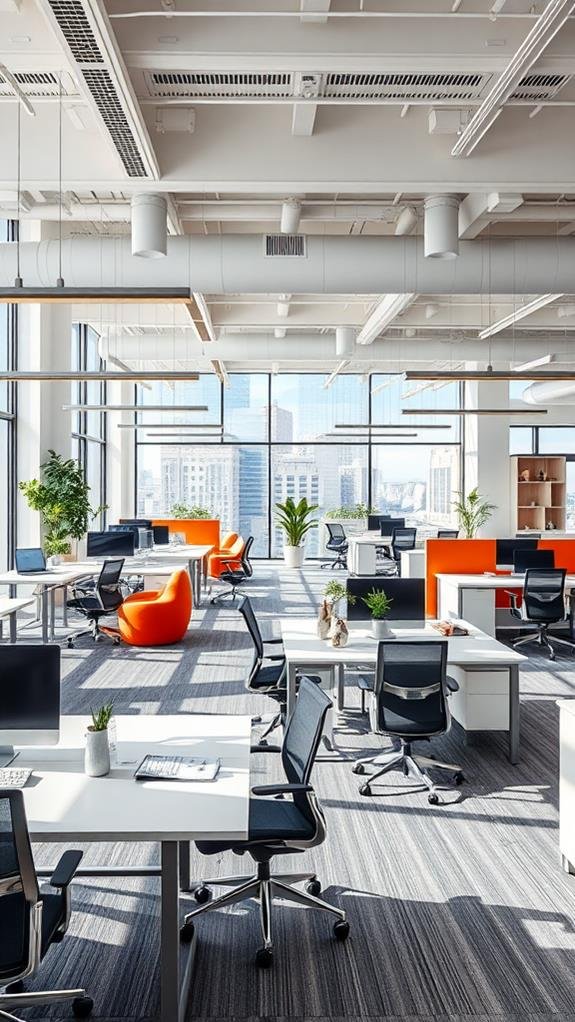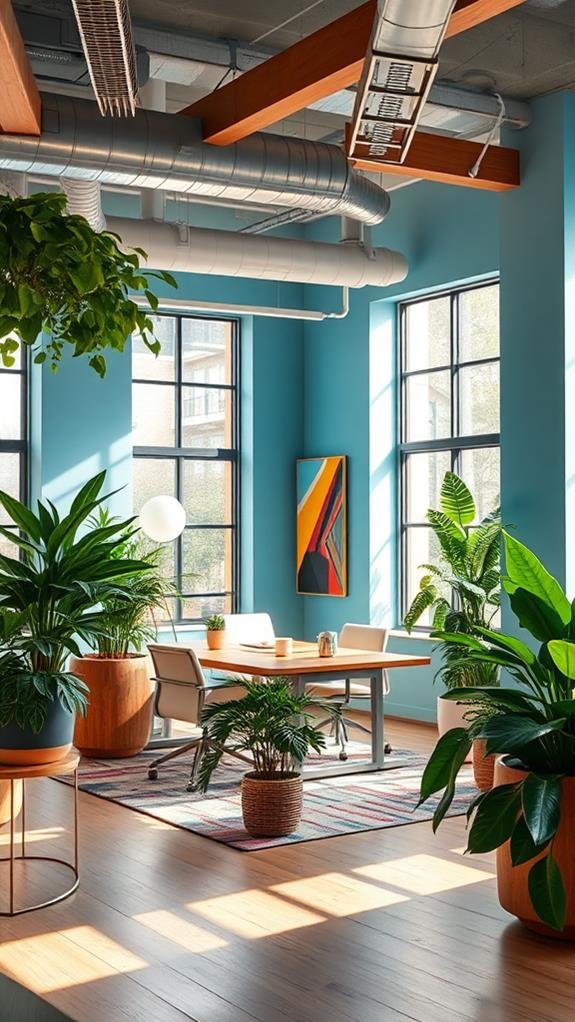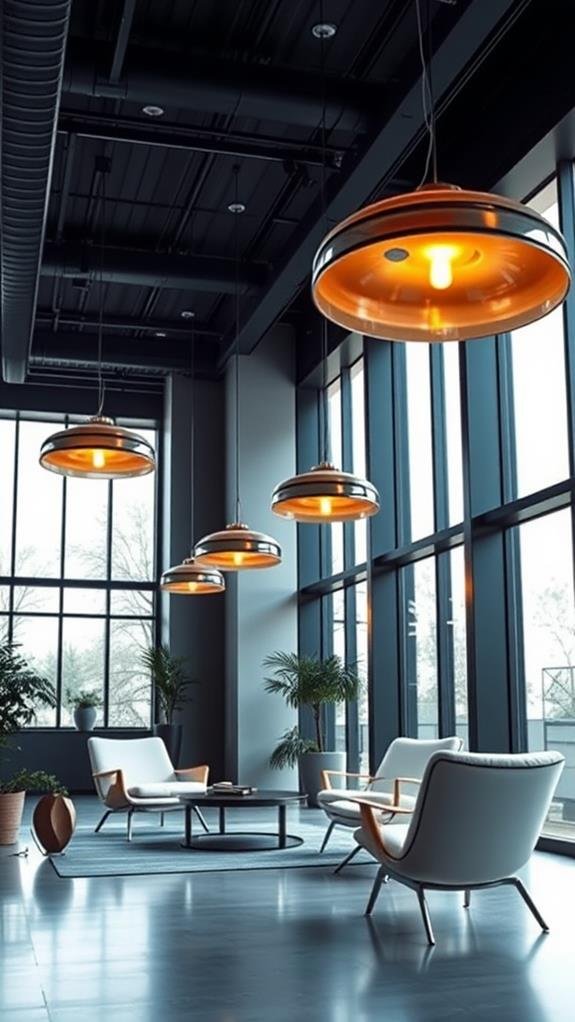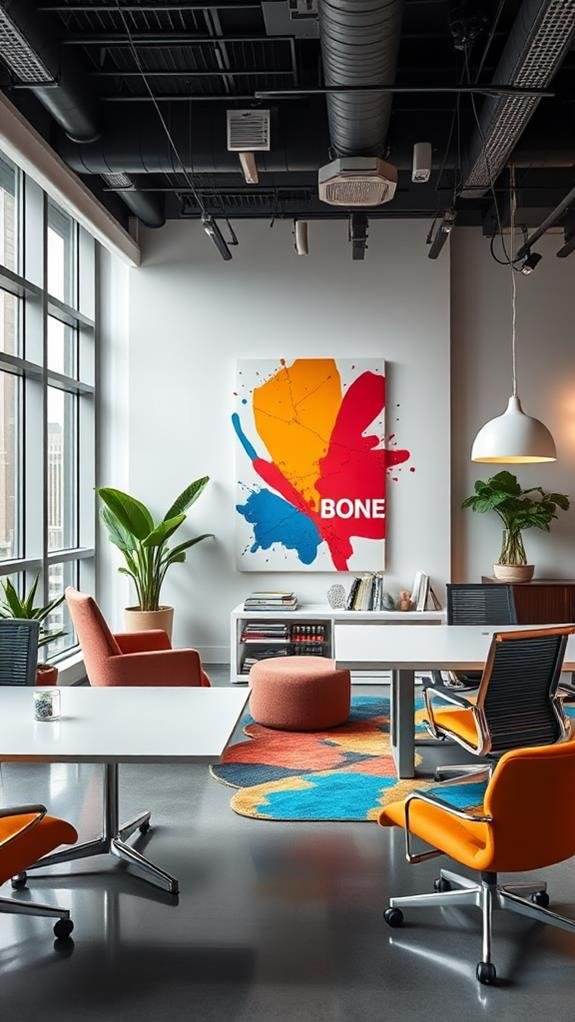7 Essential Elements in Office Interior Design
To create a great office environment, focus on seven essential design elements. First, layout and space planning should maximize productivity and comfort by grouping similar tasks. Next, use color psychology: blue calms, yellow inspires creativity, and green promotes relaxation. Don’t forget lighting design—mix natural and artificial light to reduce eye strain. Choose ergonomic furniture to improve comfort, and add biophilic elements like plants for better air quality. Consider acoustic solutions to minimize noise distractions, and incorporate personalization and branding to strengthen team connection. Each of these elements plays a key role in creating a welcoming workspace that motivates everyone. Investigate more tips for a fantastic office!
Key Takeaways
- An effective layout promotes productivity by grouping similar tasks and ensuring ample personal space for employees.
- Color psychology plays a crucial role; blue enhances focus, while yellow stimulates creativity in designated spaces.
- Proper lighting combines natural and artificial sources to reduce eye strain and create a comfortable ambiance.
- Ergonomic furniture selection is vital for prolonged comfort, while cohesive design elements uplift morale and organization.
- Incorporating biophilic elements, such as plants and natural materials, enhances well-being and connects employees to nature.
Layout and Space Planning

When designing an office, effective layout and space planning are essential for maximizing both productivity and comfort. Start by considering how you want your workspace to function.
Group similar tasks together; for instance, place collaborative areas near workstations to encourage teamwork. Ascertain there’s enough room for movement; cramped spaces can lead to frustration and decreased efficiency.
You should also think about the furniture arrangement—position desks to utilize natural light while avoiding glare on screens. Don’t forget about personal space; employees often feel more comfortable when they’ve a bit of room to breathe.
Color Psychology

In a vibrant workspace, color psychology plays an essential role in influencing mood and productivity. The colors you choose for your office can markedly affect how people feel and work.
For instance, blue is known for promoting calmness and focus, making it a great choice for areas where concentration is key. In contrast, yellows can inspire creativity and energy, perfect for brainstorming spaces. Greens often create a sense of balance and relaxation, while reds can boost excitement but may also cause stress if overused.
When designing your office, think about how different colors can impact the atmosphere and help create an environment that encourages teamwork, creativity, and productivity. Choose wisely, and let colors transform your workspace!
Lighting Design

Color choices can set the mood in your office, but lighting design is just as essential in shaping the overall work environment. The right lighting can improve productivity, reduce eye strain, and create a welcoming atmosphere.
Consider using a mix of natural light and artificial lighting to balance brightness throughout the day. Adding task lighting, like desk lamps, helps focus on specific areas, making work easier.
Meanwhile, ambient lighting softens the space, creating a comfortable feel. Don’t forget about accent lighting to highlight artwork or architectural features, adding personality to your office.
Furniture Selection

Selecting the right furniture for your office isn’t just about aesthetics; it’s about functionality and comfort too.
You’ll want to choose pieces that support your work style. For instance, an ergonomic chair is essential for long hours at a desk, ensuring you stay comfortable and productive.
Desks should offer enough space for your computer, documents, and personal items without feeling cluttered. Don’t forget about storage solutions like cabinets or shelves that help keep your workspace organized.
Additionally, consider your office’s layout—furniture should improve movement and not create obstacles.
Finally, think about style; cohesive colors and designs can boost morale.
With thoughtful furniture selection, you’ll create an inviting and efficient work environment that everyone will appreciate.
Biophilic Elements

Integrating biophilic elements into your office design brings nature indoors, fostering a sense of well-being and productivity. You can achieve this by incorporating plants, natural light, and organic materials.
Adding greenery, like potted plants or vertical gardens, not only makes the space visually appealing but also bolsters air quality. Large windows or skylights maximize natural light, creating a bright atmosphere that boosts energy levels.
Use wooden furniture or stone accents to evoke a natural feel, drawing on textures and colors found in nature. Even artwork depicting landscapes or nature scenes can amplify this connection.
Acoustic Considerations

When designing your office space, paying attention to acoustic considerations is essential for creating a productive environment. Noise can easily become a distraction, so you’ll want to think about how sound travels and how to control it.
Start by using carpets or rugs, as they help absorb sound and reduce echo. Consider adding acoustic panels to the walls or using ceiling tiles specifically designed for sound absorption. You might also choose furniture that limits noise, like upholstered chairs.
For open spaces, think about setting up quiet zones where employees can focus without interruptions. Creating a balanced acoustic environment not only boosts productivity but also makes the workplace more comfortable and enjoyable for everyone involved.
Personalization and Branding

Creating an inviting office atmosphere hinges on effective personalization and branding, which help employees feel connected to their work environment. When you incorporate elements that reflect your company’s values and culture, it inspires collaboration and creativity.
Consider using colors that represent your brand or displaying your logo prominently in the office. Personal touches, like individualized workspace decorations or shared team photos, can also elevate a sense of belonging.
Don’t forget about functional branding; designs should support your employees’ daily tasks while reinforcing your identity. Remember, the goal isn’t just to impress visitors but to create a space where your team feels at home, motivated, and engaged.
Conclusion
Incorporating these seven essential elements into your office interior design can make a big difference. By focusing on layout, color, lighting, furniture, nature, sound, and personalization, you’ll create a space that’s not only functional but also inspiring. A well-designed office can boost creativity, improve mood, and increase productivity. So, when planning your workspace, remember these tips to craft an environment that feels good and works well for everyone. Happy designing!
